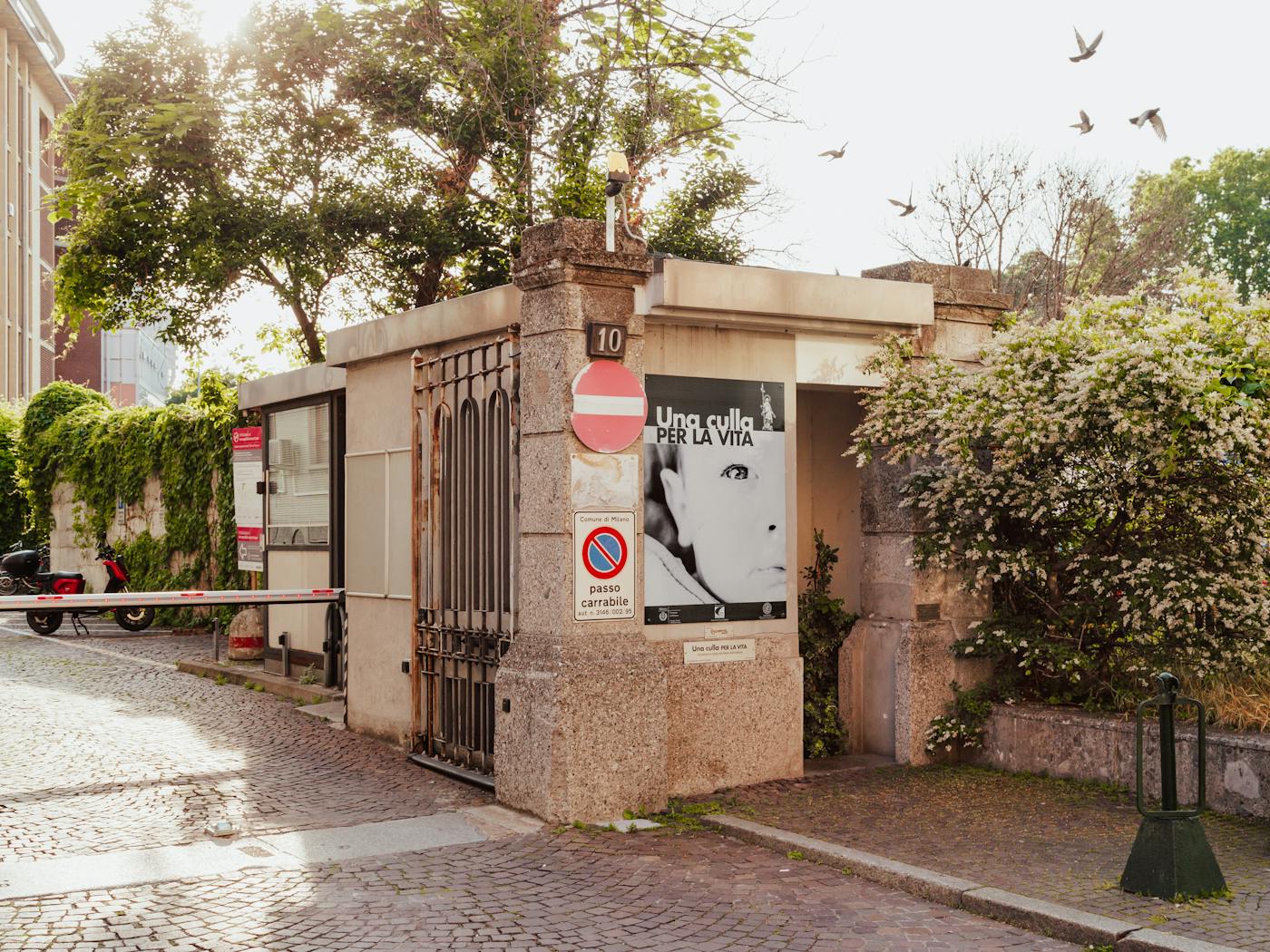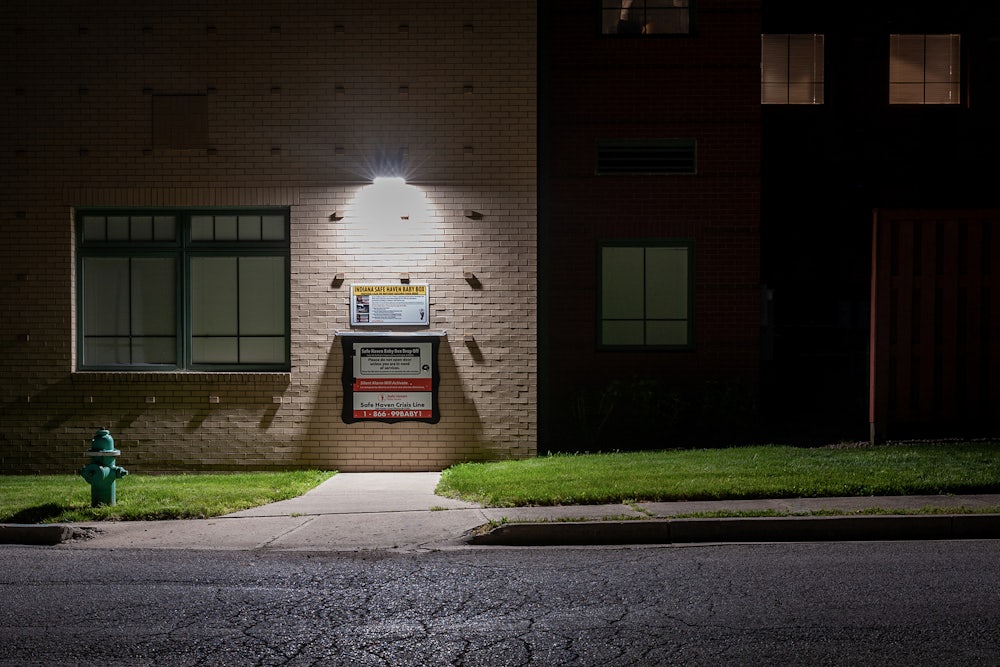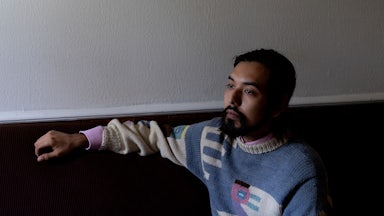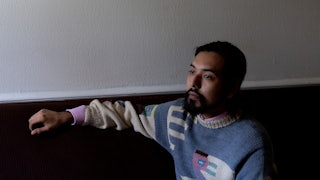Last fall, in those early months of dazed disbelief over the Supreme Court’s decision to overturn Roe v. Wade, a local Ohio television reporter stood in front of one of the state’s eight installed “safe haven baby boxes,” places where mothers can anonymously relinquish their newborns. Her plaintive expression belied her breezy demeanor and cheery chartreuse dress. The reporter’s unease did not stem from a sadness at the idea that a mother would dispose of a newborn in such a fashion. In fact, quite the opposite: It arose over a deep concern that mothers were being prevented from abandoning their newborns. The use of this baby box at a fire station in the city of Troy had been threatened, she told her viewers, because of a citizen’s complaint to the state health department charging that it failed to comply with necessary codes.
The reporter from WKEF, a station owned and operated by the conservative Sinclair Broadcast Group, shared the fire department’s frustration: “It is so easy to use,” she explained. “All parents have to do is come in, open this lever here and place the baby inside an environment that is temperature-controlled, and there’s air flowing. Now once this lever over here is pulled, 911 is immediately dialed, and law enforcement comes here to this location to pick up the child and take it to the area hospital.”
The race by the anti-abortion movement to install safe haven baby boxes across the country has accelerated post-Dobbs from zero to 60. More than a dozen states have put forth bills to broaden the use of these devices. The Ohio Department of Health green-lit the Troy baby box a mere three days after the Supreme Court overturned Roe. Print and broadcast media spread the word of the public abandonment of a baby like celebratory national birth announcements: “A Kentucky infant last week became the first in the state to be left at a ‘baby box’ under a new state law permitting the anonymous drop-off of newborns,” cooed the New York Post in February, the story also reported by CNN, CBS, and, of course, Fox News. “There is no one to stop them. There really is no one to stop them,” said Greg Luce, a Minnesota-based attorney who founded the Adoptee Rights Law Center, repeating his words in disbelief of what he’d witnessed. Controlling the debate by declaring that a baby could die without the presence of one of these “newborn safety devices,” the right is readying for a future where fire station baby boxes are as common as hose and ladder.
Even more disturbingly, Supreme Court Justices Samuel Alito and Amy Coney Barrett both cited “safe haven” laws, the legal mechanism allowing new mothers to surrender their infants anonymously, without fear of criminal prosecution, as a “modern” development, in Alito’s words in Dobbs, that obviated the need for abortion. Over the last quarter-century, the anti-abortion movement has maneuvered public policy with an acute understanding that one means to achieve their long-dreamed-of goal of a total ban on abortion is to portray adoption as the only humane solution to unwanted pregnancies. And safe haven laws and baby boxes fit perfectly into this agenda.
For the uninitiated, safe haven baby boxes resemble large ovens—steel door contraptions that unlock to reveal an interior door containing a plastic bin lined with a thin cushion, the place into which a mother can anonymously deposit her newborn. The act of abandoning an infant to a public space, once a crime, today is an invitation for traumatized mothers coaxed by young, blonde-haired reporters in bright green dresses to place their baby inside and walk away. Neighboring Indiana, educational home of Barrett, lifelong hearth of Mike Pence, and now baby box capital of America, has installed 98 of the country’s 148 safe haven boxes, and the number keeps growing.
“We’ve had a record year,” boasted Monica Kelsey, founder of Safe Haven Baby Boxes, in a video posted on Facebook just a couple of weeks after the overturning of Roe. “We’ve had a total of six babies in Indiana, one baby in Arkansas.” In addition to these “seven babies in boxes,” she enthused, one Indiana town set a new record—three babies had been abandoned within six weeks to “the same stinkin’ box in Carmel!” You see, it is so easy to use.…
How did this happen? How did a desperate and once criminal act get turned into a good thing?
America’s safe haven laws and baby boxes, a manifestation of the medieval Italian system of anonymous infant abandonment, are among the most vivid modern expressions of the Roman Catholic Church’s centuries-long shaming of women for their sexuality and assertion of control over their bodies. An ultra-conservative Catholic Supreme Court majority used safe haven laws in part to justify ending abortion—and in doing so widened a trap into which too many progressives had stepped. The potential consequences—for our politics, yes, but mainly for the emotional and psychological health of these mothers and their children—are chilling.
The idea behind safe haven laws was to stop maternal infanticide, the extraordinarily rare, headline-grabbing story of a newborn found in a garbage can. The movement quickly gained steam after the first safe haven law, also known as the “Baby Moses” law, passed in Texas in 1999, signed by Governor George W. Bush. By the next decade, safe havens would become law in all 50 states.
Legislators approved them rapidly, often with bipartisan support and little inquiry into the long-term consequences of anonymous abandonment on birth mothers and their children, and in all likelihood without an understanding of how anonymous surrender had been used historically to control the reproductive behavior of women. In several states, Planned Parenthood and NOW added a collaborative voice, joining their usual adversaries. Planned Parenthood of Northern New England went even further: It designated all of its Vermont health centers safe haven locations welcoming relinquished infants up to 30 days old. In both a naïve attempt to find common ground with the anti-abortion movement by showing support for adoption and a political dodge to avoid the accusation of allowing babies to get dumped in garbage cans, too many on the left acquiesced to the safe haven movement. The jaw-dropping decision of Planned Parenthood to print brochures announcing that its Vermont clinics doubled as infant abandonment centers most likely emerged from a squishy concept of choice—as if it were just another hue added to the palette of pregnancy options. (Planned Parenthood didn’t respond to my request for comment.)
One of the few people back then to question this near-unanimous fervor was Carol Sanger, a Columbia University law professor specializing in reproductive rights. Her journey to understand what was happening in state legislatures began, of all places, on a New Jersey Transit train. Looking out the window, she encountered a billboard emblazoned with the words NO SHAME. NO BLAME. NO NAMES, accompanied by an 800-hotline number. The billboard startled the legal scholar, long attentive to how law regulates mothers’ decisions to separate from their children. Had she just in a passing glance witnessed the state of New Jersey urging women to abandon their babies? The traumatic act of anonymous surrender reduced to a catchy slogan?
But by then the safe haven train had already left the station, with seemingly everyone on board. Acts of public abandonment, however, were not a particularly pressing social issue—in 1998, the year before the Texas law passed, a study by the U.S. Department of Health and Human Services found that of nearly four million live births, 105 babies had been abandoned in public places, with 33 found dead.
Each was a tragedy, but maternal filicide falls low on the register of reasons for infant death. Far more pressing and less sensational causes—low birth weight, preterm birth, and pregnancy-related disease complications—did not receive as much enthusiastic attention from impassioned legislators. (Nor has the death of children from gun violence, along with its profound psychological toll, forever etched into public consciousness after the Columbine school shooting massacre in 1999, the same year the Baby Moses law passed in Texas.) And because safe haven laws exist on the premise of anonymity, they can feed a culture of shame and concealment, one that can create a destructive spiral leading women to forgo counseling and maternal care, the primary ways to address infant mortality.
“The need for anonymous abandonment in 2006 puzzles and disturbs,” Sanger wrote in a prescient Columbia Law Review article published that year. “After all, subsistence levels in the United States are satisfactory, contraception is generally available, and abortion is legal. Single motherhood is less stigmatized, and the institutions of adoption and foster care are well established. How is it then that against a menu of medical, social, and legal alternatives, concealed pregnancy and infanticide have made such a comeback?”
The legislative zeal, especially on the part of Republicans, suggested that something else was happening. What may have begun as a media-induced frenzy over a handful of reported cases of infanticide soon became a shrewd mechanism for the anti-abortion movement to recast the debate by linking the act of infanticide to the decision to have an abortion. Emphasizing the urgent need for safe havens helped paint a dark portrait of a country in moral decline, where madwomen emerge from the attic and Medea crosses the border to the United States. Monstrous mothers—mothers, that is, who kill, or callously abandon, their infants—exhibit a depravity not far on this warped continuum from another type of woman, the one who ends her pregnancy. It’s a line of thinking that has culminated today in the concept of “fetal personhood” as the movement pushes for a total ban on abortion.
Sanger’s article not only saw behind the laws but predicted their inevitable outcome: “By connecting,” she concluded, “infant life to unborn life and infanticide to abortion, Safe Haven laws work subtly to promote the political goal of the culture of life: the reversal of Roe v. Wade.” Safe haven laws both framed abortion as murder and offered a “moral” alternative to abortion: Women stripped of choice could perform the selfless act of giving up their child for adoption.
The phrase “culture of life” became part of the Republican vernacular after Pope John Paul II used it in an encyclical in 1995. He asserted its necessity in the face of a growing “culture of death,” of which abortion was a major culprit. (The pope also believed that condoms were part of the “culture of death,” even if used to prevent fatal infection.) The Republican Party included the Vatican dictum in its 2004 platform, and President George W. Bush tied it like a bow around his anti-abortion agenda, uniting evangelicals and conservative Catholics and hindering scientific progress by eliminating funding on new stem cell lines. The pope’s words marked the second time in the second half of the twentieth century that Vatican language shaped the message of America’s anti-abortion movement. Most famously, Pope Pius XII introduced the term “right to life” in his 1951 encyclical to midwives, a phrase that became the movement’s post-Roe rallying cry. The child in the womb, he wrote, “has the right to life directly from God and not from his parents, not from any society or human authority.”
At the start of the millennium, during a more generous time for women’s reproductive freedom, safe haven “baby boxes” to accompany the newly passed laws did not yet exist. The boxes arrived in the United States in 2016, brought by Monica Kelsey, an Indiana resident and herself an abandoned infant. Kelsey introduced the idea after seeing this type of device in Cape Town, South Africa, three years prior, where she had been invited to give an abstinence talk at a church.
The motto etched on each unit’s interior hatch—SAVING BABIES ONE BOX AT A TIME—lends insight into what lawmakers may have been thinking when they feverishly passed safe haven laws in the prior decade. How could any decent-minded person challenge a temperature-controlled unit, rather than, as the Troy fire department chief suggested, a “cardboard box in front of our doors that we might not know is there until we check in the morning”?
Kelsey may have believed she was copying her innovation from South Africa, but tracing the genealogy of safe haven laws and baby boxes requires traveling back to thirteenth-century Italy, home of the original abandonment wheel, the ruota. Desperate single mothers placed their babies in these cylindric devices and, with a single turn, the infant left the mother forever, deposited inside a foundling home.
In 2006, Italy’s anti-abortion movement, communicating the Vatican message of the “culture of life,” reintroduced the ruota in a high-tech, temperature-controlled version, rebranding the ancient wheel as the culla per la vita, cradle for life, and installing them throughout Italy. In the United States, Kelsey charges between $11,000 and $16,000 for her copy, the less cleverly named “baby box,” along with leasing fees. (On her website, she also sells $45 tumblers displaying the safe haven logo.)
Americans may tend to think of Italy as the land of mamma e bambini, brimming with maternal love—in contrast to the ascetic Irish soul that conjured up the Magdalene Laundries. But it was the Italian church that led the Western world in determining what kind of woman was fit to be a mother. In the Middle Ages, the church invented the system of anonymous surrender to prevent infanticide, just as America’s “modern” safe haven laws—under Alito’s “War is peace, freedom is slavery, and ignorance is strength” logic—purport to do. Soon the practice of surrendering babies to wheels spread from Italy to most of Catholic Europe and Russia, becoming a mechanism to control the reproductive behavior of women. In other words, the Roman Catholic Church, not the U.S. Constitution, laid the originalist argument for safe haven laws and baby boxes.
For centuries, the church kept women under surveillance—as Texas and Oklahoma laws offering bounties to citizens who report abortions do today—requiring midwives to inform priests of all out-of-wedlock births. Mothers considered unfit were forced to surrender their babies to foundling homes run by the church and financed by the state. Brown University professor and Pulitzer Prize–winning historian David Kertzer described in his book on the Italian infant abandonment system, Sacrificed for Honor, how over half of surrendered babies died before their first birthday, a rate more than double that of the general population, from disease and from malnutrition due to a lack of wet nurses. Over this period, before the invention of infant formula, hundreds of thousands of infants died. But the church rationalized removing babies from the nourishing breasts of their “sinful” mothers to starve in foundling homes because the babies were protected by baptism—saved from sin on Earth. Kertzer quotes a nineteenth-century reformer who suggested the motto HERE CHILDREN ARE KILLED AT PUBLIC EXPENSE be placed above the doors of every foundling institution.
Pressure from reformers closed the barbaric wheels at the end of the nineteenth century. In Florence today, the Museo degli Innocenti stands in the space of the city’s former foundling home. Contained inside are tarnished relics of this sorry past. In its most heartrending section, a physical manifestation of the broken mother-child bond, 144 teak drawers slide open to display delicate objects that had been severed in half. These tokens, called segnali di riconoscimento, signs of recognition, taken from the museum’s collection of 40,000, include crucifixes, medals, and holy pictures. Each severed piece had been pinned to the swaddled infant in the small hope that the mother, who kept the other half, could one day reclaim the child she anonymously surrendered. In a chilling American parallel to the Italian system, when safe haven laws passed at the dawn of the twenty-first century, some states gave mothers an identifying token or bracelet as a keepsake for possible future reunification. But Sanger pointed out the legal caveat: “Possession of the matching token does not assure the child’s return—it simply creates a presumption of standing to participate in a custody hearing.”

To look back to the ancient origins of safe haven laws and baby boxes is not merely to provide a curious historic footnote, but to offer a cautionary tale of how the past dwells in the present and finds new routes to shape the future. Although the wheels closed, Italy’s foundling home system remained opened (sans wheel) up into the 1980s, and between 1950 and 1970 the country sent thousands of anonymously surrendered children to the United States for adoption. Over seven centuries later, the wheel’s foundational logic remained in place—the emphasis on the unwed mother’s right to secrecy in order to veil her shame, the complete lack of responsibility assigned to the father, and the ecclesiastical and lay belief that religious authorities could better determine the proper upbringing for these unfortunate babies—the ones, that is, who survived.
Left in Italy’s wreckage are countless twentieth-century women who, deprived of reproductive choices, found themselves trapped in situations outside their control, some tricked, lied to, even told their baby had died to smooth the adoption process. Their children were denied their birth identity, vital family medical history, and made to believe that their mothers had heartlessly abandoned them. Only when birth control and abortion became legal in the ’70s and the stigma of unwed motherhood diminished did the institutions’ doors finally shut, along with the international and domestic adoption pipeline this system abetted. Although Italian women could sign their names to relinquishment papers, the church preferred anonymity to make lineage untraceable. The State’s Registrar of Births falsified the children’s birth certificates, printing fictitious names on legal documents.
The Italian experience affords a rearview mirror account of our country’s ongoing crisis created when the state imposes laws based on church teachings. When a Catholic conservative Supreme Court majority overturns Roe; when states seek to send both providers and pregnant women to jail; when new mothers, cornered by life circumstances and absent necessary resources, have no choice but to relinquish the baby they nurtured in their womb to a hospital, church, or fire station baby box—these are the violent marks of the exploding star of religious fervor that has crashed onto public policy.
More than 800 years later, anonymous surrender remains in Italy’s legal code, despite centuries of efforts by reformers to repeal it. The country “still is not ready” to abandon the law, Anna Arecchia, who heads the Committee for the Right to One’s Birth Origins, told me. And now anonymous surrender, i.e., safe haven law, is ensconced in every U.S. state. What neither liberal lawmakers who offered a bipartisan handshake, nor Democratic-controlled legislatures, nor NOW or Planned Parenthood understood was that they had unwittingly introduced the ideological extension of thousands of years of Catholic Church thinking about women, sex, and sin into U.S. jurisprudence.
“This is deeply embedded in Catholicism,” said Frances Kissling, president of the Center for Health, Ethics, and Social Policy and a former nun. “This is about the fact that you had sex that you were not entitled to have, and in one form or another we are going to punish you for that. And one of the punishments … is to take your baby away.”
The number of infants relinquished to safe haven locations since the early 2000s is hard to discern, because the federal government doesn’t compile such statistics. Nor has the government published another official tally of babies left in public places since the 1998 study. (An unpublished follow-up written in 2010 cited 83 infants in 2006.) To date, the number of newborns placed into baby boxes appears to be tiny, a little over a couple of dozen, a figure gleaned from news reports and pro-baby-box social media. But those dozen-plus states considering expanding the use of baby boxes mean it’s far too early in our post-Dobbs land of re-criminalized abortion to know how many children will end up relinquished to baby boxes; or, through the use of safe haven laws, to designated sites like hospitals and churches; or how they will fare. And the troubled lives of the women who gave birth to them, along with the slim options for reclaiming their children, rarely find a space in the public imagination.
The oldest babies surrendered through safe haven laws would now be in their twenties, but unless a mother volunteered information, there is no original birth record. “The damage of safe haven laws is there, and even the work I do doesn’t touch those cases, because in many cases there was not a birth record,” explained Greg Luce. “Or the birth record is called a foundling certificate, where your place of birth is where you were found, and your father or your mother may be listed as the person who found you. But you can’t even get those records at all. The foundling certificates are sealed and completely unavailable.”
There is, however, another entry point into understanding the lifelong complexity of anonymous surrender laws for birth mothers and their children, as well as the kinds of abuses their secrecy encourages. Traveling around three-and-a-half hours east of the Troy fire department’s endangered safe haven baby box, to the town of Steubenville, Ohio, affords such a periscope view.
Steubenville, with a population today of about 18,000, is a small town with an outsize reputation. It received international attention about a decade ago when two popular high school football players sexually assaulted a 16-year-old girl after she passed out while drinking with them at a party. The players texted photos of the unconscious girl to their friends, who laughed about how “raped” she looked. As the town doubled down to defend the boys, the group Anonymous hacked into their social media accounts, and the texts and video spread around the world, prompting outraged conversations about sexual assault, protecting athletes, and victim shaming. If that distinction (along with being the birthplace of Dean Martin, who, in an era slow to rise to outrage about such matters, crooned, “Baby, it’s cold outside”) weren’t enough, Steubenville holds yet another. In the ’50s and ’60s, it welcomed an unusually large cluster of more than two dozen Italian children out of thousands adopted by American couples through a program run by the Vatican and the U.S. Catholic Church that supplied children from Italy’s opaque infant abandonment system.
Few people, even in Italy, know today that more than 3,700 children arrived in the United States on commercial airlines—far more than the children adopted from Ireland’s Magdalene Laundry system—between 1950 and 1970. During this time, tens of thousands of unwed Italian mothers were forced by religious, social, and economic pressure to relinquish their babies. (In the program’s most delicious irony, these children sent to the United States to be exculpated from sin spent their first night before meeting their new parents at Manhattan’s Chelsea Hotel, infamous for its debauchery, but also a convenient 10-minute walk from where the offices of the Catholic Committee for Refugees once stood.) The children arrived under a refugee status, marketed first as “war orphans” and in later years as “orphans,” although almost all had two living parents.
Those thousands of children helped serve a Vatican postwar social experiment—removing Italy’s unfortunate “illegitimates” to be raised by couples in America’s land of plenty. The childless American couples needed to demonstrate, in the words of the monsignor in charge of the “orphan program” in Rome, an “impeccable Catholicity.” Adult adoptees from Steubenville have only recently learned, after finding one another through an online group, that the boy they waited for the school bus with or the girl they sang next to in high school choir had, like them, spent their first years in an Italian foundling institution before being replanted into America’s Catholic heartland. It’s a discovery that “completely blows my mind,” several adoptees repeated.
I stumbled upon this story several years ago because of a chance phone call from my cousin, in which he offhandedly mentioned that he had joined an online group for people like him, born in Italy and adopted in the United States through a Catholic Church program. He began telling me stories he’d heard from other adoptees about the treatment of birth mothers and children—stories that disturbed me.
My interest piqued, I asked my cousin, flown to the United States in 1959 at nine months old to be adopted by my father’s niece, a nurse, and her husband, a popular Steubenville doctor, to connect me with the American adoptee who created this group. Soon I was talking to John Campitelli, a Cornell-trained engineer and IT provider. Anonymously surrendered in Turin, Italy, in 1963 and adopted by an American couple in 1965, Campitelli began searching for his birth mother at the tender age of 11, finding her two arduous decades later. He learned how nuns had lied when his mother hoped to reclaim him, sending her away from the foundling home where she had been forced by religious and family pressure to surrender her son, whom she named Piero, days after his birth. Her son, they told the 23-year-old mother, was already in the United States with “a good family.” In truth, he lingered in the institution for nearly two years.
My cousin, also named John, had been surrendered to the same Turin institution. One summer night, I talked with him and four other Steubenville adoptees, all members of Campitelli’s group, in an extended Zoom call. The screen, uniting adoptees who long ago moved from Steubenville, allowed me entrée into the lived experience of the dozens of children who had arrived from Italy into this tight-knit Midwestern town. Mary, the youngest and among the last of the children sent to the United States in 1968, was the firebrand among them, most vocal in calling out the harm inflicted by the absence of any support network for these families. As the adoptees shared what little information they knew about their early years in Italy and reminisced about growing up in Steubenville, the conversation had the feel of part support network, the kind Mary wished had existed in their youth, and part reunion, even if some were meeting for the first time.
Mary also retreated at times that evening, becoming very quiet as she listened to the stories of others and reflected on her own. Mary bears a double burden, because she had been adopted with her younger brother. Her parents had intended to adopt only the six-month-old boy but were persuaded by local priests to take his toddler sister. “I’m the two-for-one special,” Mary quipped, but also the family’s sole survivor.
“He hated the whole fact that he was adopted,” Mary said. “He wanted nothing to do with it.” She still has difficulty talking about her brother 30 years after his suicide devastated their family. There were other circumstances, such as her brother struggling with issues of his sexuality, which began in high school and continued into college. “But I think adoption really played heavy on that, and later after his suicide I learned that there are mental health issues in my biological family,” she said. “I’m like … what do I do with all these mental health issues? It scares me sometimes, even to this day.” As family stories were shared, the complex choice confronting the adopted child—whether or not to search for one’s past—surfaced repeatedly. It was summed up in a succinct exchange between an adoptee who wondered whether looking for his origins would be “opening up a can of worms” (my cousin shares this point of view), and another named Marco, who retorted, “I’ll open that damn can. I’m pretty stubborn.”
Marco, married and a father of four, turned 66 in April and is still trying to open that damn can. Although Marco, like my cousin, and like John Campitelli, had a close and supportive relationship with his adoptive parents (Marco’s father was the best man at his wedding), he has spent a lifetime hoping to discover who brought him into the world, and if he has any siblings. For his birthday this year, he traveled to Sardinia, where he was born and spent two-and-a-half years in a foundling home, for the first time since then. Marco has never been able to uncover the story of his birth mother. A nun told him when he was around 15 that she died during childbirth. It was a pat line fed to other questioning children, and it made his birthdays from that point on bittersweet, since Marco held himself responsible for killing his mother.
His two official identifying documents, an Italian birth certificate and passport, informed him that he was born Marco Santelli and initiated a decades-long quest to learn more. He met a fellow Santelli on an ancestry site, and even traveled to the Florida retirement home where she lived. When she persuaded Marco to attend a large Santelli family reunion in Toronto, he agreed, flying there with his wife. It turned out, though, that it was all a waste of time. Only after meeting John Campitelli, who explained to Marco that he was anonymously surrendered, did this adoptee discover that his birth certificate had been falsified by Italy’s Registrar of Births.
The person assigned to his files might have chosen the name “Marco Santelli” as an antidote to the sins of his mother, renaming him a devout little saint, santo, born on April 27, two days after the Festa di San Marco. But in the back-to-Earth reality of one’s life, this mythical falsification of an official document, embossed on a passport bringing the child into the United States, resulted more than four decades later in Marco traveling nearly 3,000 miles, from Ohio to Florida to Toronto, all in the vain effort to find a family connection to a family that never existed.
Despite the celebratory coos in the United States today about anonymously abandoned infants rescued at safe haven baby boxes, Marco’s story is one of countless tales of adopted children around the world who have wanted to find their birth mothers—along with mothers hoping to find children they were forced or tricked into giving up—only to be frustrated at every step by deliberate falsifications and sealed records. Even DNA testing has failed to give Marco any helpful leads.
Milan-based psychologist Francesco Vadilonga, who works with adoptees seeking their biological families, told me that searches often are triggered not just by the desire to find the women who brought them into the world, but by a belief that a piece of oneself has been lost. The culture of adoption in Italy, Vadilonga explained, long veiled in secrecy because of anonymous surrender, reinforces the desire to shut the door to the past, and with records mandated by the courts to be sealed for 100 years, it leaves adoptees with few options but to accept this erasure.
Adoption is the new front line in the ongoing battle for women’s bodily autonomy, and the anti-abortion movement is using adopted children as its political football. The only moral solution to an unwanted pregnancy, this thinking asserts, is for women to do the right thing: carry the baby to term and relinquish the child for adoption.
The handmaiden of this argument is Amy Coney Barrett, who was educated and who later taught at Notre Dame Law School, which helped develop the Catholic conservative legal thinking in the anti-abortion movement. She stunned pro-choice advocates during oral arguments for Dobbs in December 2021 when she asked why, if a woman can have an abortion at 23 weeks, the state cannot require her to carry the baby for 15 or 16 more weeks. Barrett suggested that because safe haven laws allow women to terminate parental rights as early as 48 hours after birth, they eliminate the need for abortion through the act of anonymous surrender that provides a route to adoption.
The left hadn’t considered this argument in the game of chess over Roe: that a member of America’s highest court would justify forcing a woman to carry to term with the blithe notion that she can always abandon her baby to the box at the local fire station. In fact, after the rapid passage of safe haven legislation, many didn’t think about these laws at all. “I think that some people, even in our field, were like, ‘Wait, what exactly are safe haven laws?’” a reproductive health researcher told me about the reaction to Barrett’s questions.
“Democrats, or generally those who supported the right to an abortion, have been hoodwinked,” said Luce about liberal politicians’ failure over the last quarter-century to recognize the danger of the safe haven movement. “And it’s come back to really bite them hard, now that we’re seeing the expansion of these baby boxes and safe haven laws.” Marley Greiner, co-founder of the adoptee rights group Bastard Nation, was one of the few to oppose safe haven laws from the start. “We had no idea how far this would go, and nobody ever expected boxes,” said Greiner, who tracks with Luce the 19 states currently authorizing the use of the boxes. These adoptees are trying to halt the dismantling of a half-century of hard-fought rights and recognize the cruelty of a society that fails to offer economic or emotional support to pregnant women in need but encourages them to relinquish their children. “Baby boxes send the message that women demand anonymity, that sealed records or anonymous birth is what women want, and it makes it more difficult for us to unseal records,” said Greiner.
Adoptees understand firsthand the pain of sealed records and America’s own callous treatment of birth mothers. The postwar years came to be known as the “baby scoop” era, when an estimated 1.5 million women, predominantly white, young, and middle class, disappeared to maternity homes to hide their pregnancies and relinquish their babies for adoption. Back then, rarely was the Old World language of disgraced sinners and deserved punishment heard from social workers who excised Christian religious belief from their professional judging eye. Rather, here in the New World, popularized versions of Freudian theory justified relinquishment: Young mothers were neurotics with pregnancy fantasies that stemmed from a confused sense of womanhood.
By the 1970s, an adoption rights movement, led by people who came of age during the Warren court’s expansion of civil rights and civil liberties, blossomed as it demanded an end to secrecy and closed files. One of its leaders, Florence Fisher, explained to The New York Times in 1972 why many adoptees undergo searches: “to acquire a history and biological relatedness in a world that has asked us to live a contrived identity in a contrived reality, not just as a child, but for all our lifetime.”
The idea of “open” adoptions developed, in which the identities of the birth mother and adoptive parents could be exchanged, along with mutual consent registries enabling adult adoptees and birth parents to place their names into a large, shared database in the hope of finding each other. The obstacles remained large for broken bonds to be mended, but the vital importance of knowing family medical histories and an understanding of the pain suffered in the adoption process came to light. This awareness, combined with the availability of birth control and legalized abortion, resulted in a dramatic decline in the number of babies relinquished for adoption.
But that is likely to change now, thanks to Dobbs, along with the potential for abuse that existed in a secretive adoption system. Greiner and Luce report that they are already seeing dangerous facets of safe haven concealment. In Indiana, the baby box capital, legislation recently passed both houses that allows for the direct transfer of a newborn from a fire station baby box to a “preapproved” adoption agency without having to notify a state regulatory agency. Adoption proceedings could be initiated a mere 28 days later, with the courts prohibited from inquiring about the parents’ absence or reason for relinquishment. Giving an adoption agency full control by eliminating state or court regulation is the kind of abuse that in the past resulted in the trafficking of children. An EMS worker, for example, could be tempted by financial incentive to transfer a baby directly to an adoption agency. The other side of adoption, which no one likes to admit, is its commercial one, with costs that can exceed $50,000 for a healthy newborn.
A land of re-criminalized abortion might well usher in the old stigmas of unwed motherhood, with the “good mother” portrayed as one who surrenders her newborn to an adoptive family with the economic means to properly raise the child. Such stigmas conceal the sad truth that women relinquish their babies because of a drastic lack of choice. The vast majority of women denied access to abortion do not want to give up their child, with about 9 percent relinquishing and the other 91 percent parenting the child, according to the research of Gretchen Sisson, a sociologist at the University of California at San Francisco and author of the forthcoming Relinquished: The Politics of Adoption and the Privilege of American Motherhood. “Women are just not interested in giving their child away if any other option is a possibility,” Sisson said.
Our post-Roe land will force many more women to make these untenable choices. But with an important new addition: anonymous surrender codified into U.S. law. On Easter Sunday, a mother in Italy abandoned her newborn to a culla per la vita in central Milan near a large medical complex. Installed in 2007, this “cradle for life” had been used only twice before the 2023 surrender. Although the mother could have anonymously relinquished her newborn at the hospital where she gave birth, instead she chose the high-tech ruota.

She included a letter written in her baby’s voice, her chosen name for him referenced Aeneas, the mythical hero of Troy: “Hi, my name is Enea. I was born in the hospital because my mom wanted to be sure everything was ok and to be together as much as possible.”
This cradle-for-life Easter story, widely reported in Italy, fit not only into the Vatican message of the culture of life, but Prime Minister Giorgia Meloni’s call for “Dio, patria, e famiglia,” a motto with its roots, like her hard-right party the Brothers of Italy, in the country’s Fascist past.
Back in Troy (Ohio), the Department of Health deemed the baby box compliant and ready again for use. The right cajoled progressives to open the Trojan horse of anonymous surrender, and, soon enough, baby boxes crawled out of the woodwork. With remarkable deftness, the wheels have been set in motion to recommence this most ancient form of female subjugation. A dystopian future portends if we remain on this road the Supreme Court paved and many states already follow. The only way ahead is to stop averting our eyes to what has been before us all along.
This article has been updated.






